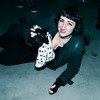"Passenger Pigeon," (Ectopistes migratorius) taxidermy, Norwich Castle Museum
Eric Hosking (1909-1991), Heraldic Barn Owl, 1948. Photograph, 28 x 42 cm, © The Eric Hosking Charitable Trust
Maker unknown, Pectoral depicting a human-bird figure, Colombia, c. 1000-1600. Gold and copper alloy (Tumbaga), 30 x 20.5 x 2 cm, © The Trustees of the British Museum
Frederick Strange (1826-1854), Adult male Paradise Parrot, Psephotus pulcherrimus, Morton Bay, Queensland, Australia (1851), extinct since 1927. Taxidermy specimen, 20.5 x 9 x 20 cm, Norwich Castle Museum & Art Gallery/Norfolk Museums Service © Norfolk Museums Service

